Election Violence
It's no longer just a Third World problem.
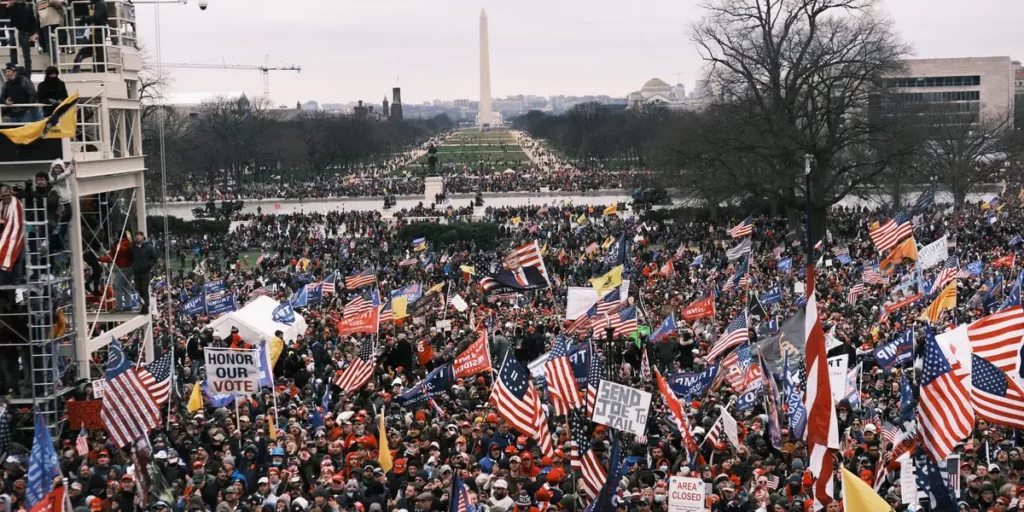
A rather sobering report from Council on Foreign Relations research fellow Jacob Ware is titled “Preventing U.S. Election Violence in 2024.”
There is a serious risk of extremist violence around the 2024 U.S. presidential election. Many of the same sources of instability and grievances that precipitated the January 6, 2021, assault on the U.S. Capitol (along with other challenges to the outcome of the last election) remain present today. And, while the risk of far-right election-related violence is greater, the possibility of far-left extremist violence cannot be dismissed. Such violence threatens individual lives and the domestic political stability of the country.
It could also undermine the United States’ international standing and foreign policy goals, in a year where at least eighty elections will take place around the world. U.S.-based election violence has already inspired one similar incident, in Brazil in January 2023, and further disruption could affect the rules-based international order in ways detrimental to U.S. interests as it embarks on a new generation in strategic competition. The United States would also benefit from serving as the standard-setter on several associated issues, such as disinformation on social media and the rise of generative artificial intelligence (AI) and its impact on elections.
Coincidentally, we just wrapped our Conflict Analysis seminars today. We’ve had the lesson in our curriculum for the last decade or so, introducing students to one of several conflict analysis (usually the Interagency Conflict Assessment Framework or USAID’s Conflict Assessment Framework but this year USAID’s Violence and Conflict Assessment tool) and having them apply it to a regional case. In recent years, many of us have also had them apply it to the United States.
Increasingly, students have come to the conclusion that the possibility for violence here is no longer theoretical. While we’re hardly Rwanda, there are simply more drivers of conflict and fewer mitigating factors than there were just four or five years ago.
Ware continues:
The first and most urgent scenario involves assassination threats against campaigning candidates and other public officials. According to Seamus Hughes and Pete Simi of the University of Nebraska-Omaha, “over the past 10 years, more than 500 individuals have been arrested for threatening public officials. And the trendline is shooting up.” In recent years, for example, the lives of Vice President Mike Pence, Speaker of the House Nancy Pelosi, and New York Republican gubernatorial candidate Lee Zeldin were all threatened. Nikki Haley, the Republican runner-up, requested Secret Service protection during her campaign, indicating that violent threats have already surfaced in this cycle as well. The United States has been spared a high-profile assassination for more than a half-century. However, lack of success should not be taken to suggest lack of intent. Precisely this point was underscored on June 14, 2017, when a far-left extremist opened fire at a baseball practice of congressional Republicans, gravely wounding House Majority Whip Steve Scalise before being killed by the congressman’s Capitol Police detail.
It’s notable that many of these threats were fomented by a certain former President—but not all of them. The Scalise shooting was certainly not MAGA-affiliated. Having treated the outcomes of our elections as existential crises, it’s not shocking that some handful is willing to use violence.
Second, large party and voter gatherings, such as the Republican National Convention in Milwaukee in July and the Democratic National Convention in Chicago in August, as well as primary elections and caucuses, could pose attractive targets. The conventions will boast the largest collections of party members and leaders throughout the entire election cycle and could therefore attract individuals or groups with a vendetta. News headquarters will also be potential targets given extremist rhetoric depicting the media the “enemy of the people.”
This strikes me as less likely, but I’m hardly an expert. Again, the increasingly hot rhetoric equating the other party as threats to the future of the Republic makes it more likely than it would have been in more normal times.
Third, dates associated with the former president’s legal troubles could also trigger violent extremists. Trump’s legal challenges have thrust the 2024 election into unprecedented territory, with the possibility of a presidential candidate running for office from the courtroom, and possibly jail. The public process and potential legal outcomes could accelerate and spur violent attacks.
While I would assess the threat from the MAGA side as substantially higher than from the Democrats, the latter is certainly non-zero. Again, if Trump’s re-election is a threat to democracy itself, taking him out is not off the table. Still, I’m far more worried about the safety of judges, lawyers, and jurors than a man with 24/7 Secret Service protection.
Once voting begins, the first and most likely scenario is violence and intimidation at polling places and against election workers, or against drive-by or drop-off balloting sites and their collection points. This could include armed militia groups “observing” the election for fraud but, in reality, intimidating voters. In 2020, for example, Oath Keepers gathered at polling places to, in Oath Keepers founder Stewart Rhodes’s words, “protect people who are voting.” Such gatherings could intimidate voters and disrupt Election Day by dampening turnout. This scenario could be driven both by any candidate calls to arms as well as by grassroots voices sensitive to local issues, vulnerabilities, and voting preferences, and to individual poll workers expressing or acting upon their personal political views. Such violence provides less of a model for partners and adversaries in the international space, given that the November election will occur after most other 2024 elections have occurred.
Once voting is completed, threats could turn against those counting the ballots. During the 2020 election, some of the more vitriolic threats were delivered against election officials in swing states. The sequencing of vote counting can play a part, such as when early, mail, and absentee ballots, which tend to lean Democratic, are counted last, leading to “red mirages” in which Republican candidates take early leads that fade in the final legal vote tally. In 2020, for example, federal agents arrested two QAnon supporters from Virginia who showed up with firearms at a convention center in Philadelphia where votes were still being counted three days after Election Day. Political calls to “stop the count” or “stop the steal” can make a violent response more likely.
Again, the threat here would seem almost entirely to come from one side.
In the post-election era, depending on election results, attacks against government buildings and/or law enforcement officials will likely be the preferred means as violent extremists aim to take the fight directly to those they deem responsible for malfeasance. This scenario was seen at COVID protests in April 2020, sprawling anti-fascist rioting that summer, at the U.S. Capitol on January 6, and the attack against the FBI in Cincinnati. Here, the main accelerant will be political rhetoric interpreted by violently inclined individuals as calls for violence. Perhaps the most significant lesson of January 6 is that even seemingly innocuous moments can provide the impetus for extremist gatherings given the right combination of messaging and momentum. Any number of constitutional milestones—when electors vote in their home states; the January 6, 2025, counting of electoral votes; or Inauguration Day itself—could thus provide the spark, particularly among far-right violent extremists. Far-left violence responding to a disappointing election result will likely be more sporadic and disorganized. Militant anarchists, in particular, could be active, as seen on inauguration day in 2017. Still, the bond between far-left anarchists and the political system is not as strong as on the right, making it unlikely that extremists respond to any call for violence from politicians.
I’m not sure I agree with that. But I do think it’s far, far less likely that a major Democratic political leader calls for violence to begin with. That seems to be almost exclusively a province of the MAGA crowd.
Should multiple, organized extremist elements take up arms in defense of their candidates or other interests, sustained violence between political factions across broad geographic spaces remains possible. This level of violence has not yet been reached during the current escalation in domestic terrorism, except at a small scale on American streets in clashes between the Proud Boys and anti-fascists. Should those skirmishes escalate, they would pose a serious threat to law and order. The gravest fear, full-scale and total civil war, remains unlikely, in large part due to the lack of safe havens or sanctuaries for extremists in the United States. Political divides today run along urban-rural delineations, not northern-southern, which will likely stunt any budding civil war in its infancy.
Thankfully, most Americans don’t care about politics enough to take up arms and risk everything to influence the outcome. I, too, judge the risk of an all-out civil war at close to nil.
There’s a whole lot more before Ware gets to the mitigation piece.
The leading reason for the rise in domestic terrorism in recent years is a heightened motive or intent toward acts of violence. Reducing motive, therefore, is both paramount to prevention and a daunting challenge. In the build-up to the election, mainstream politicians on both sides of the aisle can use their platforms to speak out against division and publicly praise the integrity of U.S. democracy. Although federal politicians have been reluctant to be outspoken against divisive politics (perhaps warily watching the examples of Republicans Liz Cheney and Adam Kinzinger, who no longer serve in Congress after sitting on the January 6 committee), state and local officials have been far more committed to upholding democratic norms in their constituencies. Many maintain the trust of a large swathe of the American people and can call for peace and calm. One example of this commitment is Republican Utah Governor (and Chair of the National Governors Association) Spencer Cox’s Disagree Better initiative, which aims “to model how to disagree better, setting an example and creating the permission structure and template for other public officials at every level to follow.” Such measures, critically, do not touch on political or ideological differences, but instead emphasize shared interests such as civil disagreement and trust and faith in democracy.
The Joe Biden administration has several options to lower the country’s temperature and promote a peaceful and orderly election process. For instance, President Biden could task agencies such as the Department of Education or Department of Homeland Security (DHS) to issue nonpartisan educational tools that teach the American public about the electoral process and its resilience to manipulation. Such positive pre-bunking could prevent electoral conspiracy theories from taking root as widely as they did in 2020. The Biden administration could also push states to reverse their vote-counting timelines to count the usually Democratic early, mail, and absentee ballots ahead of the typically Republican day-of votes—or to count votes simultaneously. Although a hard mandate to count votes earlier could violate the Tenth Amendment, gentle encouragement could help reverse the red mirage that contributed to January 6 and the “stop the steal” movement—although there is, of course, the danger of a “blue mirage” instead contributing to violence by far-left extremists. Media organizations could also avoid covering vote tallying, waiting to announce results until they are confirmed and finalized.
The Biden administration, as well as law enforcement professionals, could also look abroad for best practices on reducing intent to commit electoral violence. In Preventing and Mitigating Election-Related Violence [PDF], a policy directive issued by the UN Department of Political Affairs in June 2016, the first suggestion is “Reducing high stakes in politics, promoting measures to move away from ‘zero sum’ politics and ensuring against a monopoly of power by one group.” One possible measure to reduce intent to violence, then, would be to promote democracy’s guarantee that the voices and views of the expected losing entity can still be acknowledged and advanced despite electoral defeat. In other words, politicians could employ language promising inclusivity and unity, perhaps on issues of bipartisan concern such as immigration, providing assurances that all Americans would have a seat at the table in the new administration. As stated by UN guidance, “When parties are quite certain of loss or exclusion in an electoral contest, especially when they expect to be ‘permanent minorities’ (to lose not just once, but again and again due to patterns of identity voting), the certainty of outcomes is also a strong causal driver of violence.” In addition, the United States could publicize the cadre of international election observers to increase trust in the process.
As Bill Clinton has noted, politics—and especially political campaigning—is about emphasizing differences rather than highlighting commonalities. His antagonist, Newt Gingrich, was a master at it. And yet the two managed to work together reasonably effectively in accomplishing their overlapping goals, which were considerable.
Somewhere along the way—and it predates Trump’s 2016 election—we’ve lost that. While Republicans deserve the primary blame (things like the Hastert Rule work against compromise), it’s certainly not all their fault. As our parties have sorted, there’s just less interest in compromise.
Reducing the capability to inflict violence will also be central. Indeed, the successful application of lessons learned after January 6 would considerably strengthen the United States’ electoral resilience. Intelligence sharing between federal, state, and local partners, as well as with fusion centers (defined by DHS as “state-owned and operated centers that serve as focal points in states and major urban areas for the receipt, analysis, gathering and sharing of threat-related information between State, Local, Tribal and Territorial (SLTT), federal, and private sector partners”), is critical. Threats issued by extremist groups and networks should be taken seriously, unlike on January 6, when preparations were not commensurate with the volume of intelligence suggesting armed actors planned to descend on the capital. Government officials across the aisle could work with legacy media to emphasize the nonpartisan mandate of the DHS, FBI, and state and local law enforcement to undermine allegations of partisanship and politicization. Leaning on local police forces would also build legitimacy, allowing more trusted law enforcement to adhere to their job of keeping the peace in their communities.
At a tactical counterterrorism level, the Department of Justice’s continued legal efforts to disrupt leading domestic extremist organizations—including the Oath Keepers and Proud Boys—builds deterrence against future acts of violence. Although the leadership of both groups is already serving jail time for seditious conspiracy as a result of January 6, which has undermined both groups while building a stronger deterrent against violence, such legal efforts could continue as the election cycle heats up. Government efforts to deter or defuse violence will be complicated, however, by extremist networks’ continued adherence to the leaderless resistance (“lone wolf”) strategy, which hampers the ability of law enforcement to penetrate groups and limits the intelligence value of any individual capture. Militant anarchists, for instance, will continue to operate in spontaneous “black blocs,” which similarly complicate infiltration and arrests. Efforts to reduce particularly lethal weaponry will likely fall flat, but could still be attempted.
Finally, law enforcement agencies could remove opportunities for violence by hardening soft targets and maximizing law enforcement readiness and even preparing for military intervention. The federal government’s law enforcement agencies could seek to designate important events, such as the political conventions and the election itself, as National Special Security Events, which would open a range of new law enforcement tools to prevent and respond to violence. A streamlined electoral process, including the Electoral Count Reform and Presidential Transition Improvement Act passed in response to January 6, could also limit opportunities for violent interventions.
This all seems reasonable, if incredibly manpower intensive. It’s not a sustainable solution but would at least be viable on the most obvious targets for violence.
There’s considerably more to the report. That we’re seriously having to consider violence mitigation around our elections is a sad commentary, indeed.

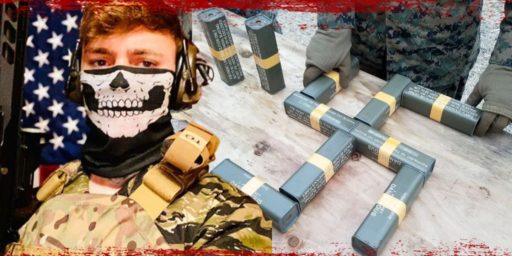
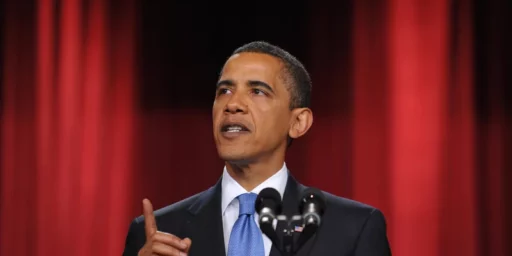
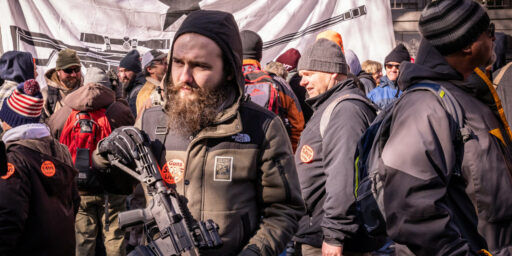
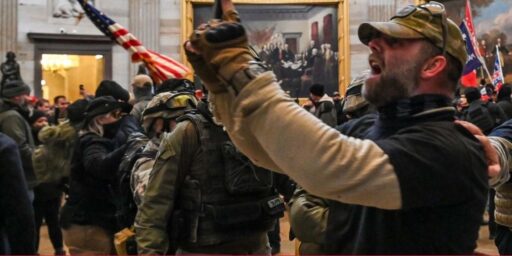
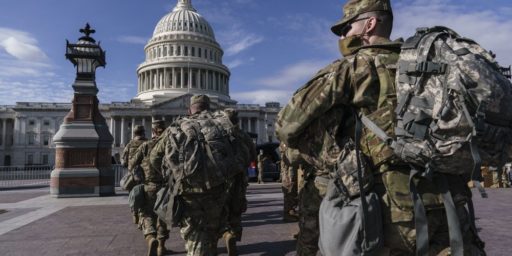
Given that the Trump campaign and the RNC today announced that they are initiating “the most extensive and monumental election integrity program in the nation’s history,” I can pretty much guarantee that there will some violence if/when Trump loses this coming November.
The only way the MAGAs will consider the election legit is if Trump wins by a landslide.
Ah yes, the Scalise shooting. Who can forget how Congressional Democrats celebrated the shooter and urged others to – wait a minute. You mean Democrats condemned the attack and upon hearing the news immediately interrupted their own baseball practice to gather for a prayer meeting to pray for Scalise’s full recovery? Wow, how different is that from how Republicans run like rabbits from saying anything remotely critical of MAGA extremists or Trump’s cheerleading.
I could also point out that the Scalise shooter was a man with a record of domestic violence who was spiraling down the drain into collapsing mental health issues. Maybe this isn’t the same as the January 6-ers, hmm?
NPR did an extended piece in their “On the Media” segment this morning, on the topic of Christian Nationalism/Supremacism and the role of nondenominational charismatic media prophets in radicalizing grass roots charismatics. The researcher being interviewed claims that the social media feeds of the convicted 1/6 insurrectionists show widespread exposure to and redistribution of those very niche feeds. It’s hard to avoid direct comparisons with ISIL.